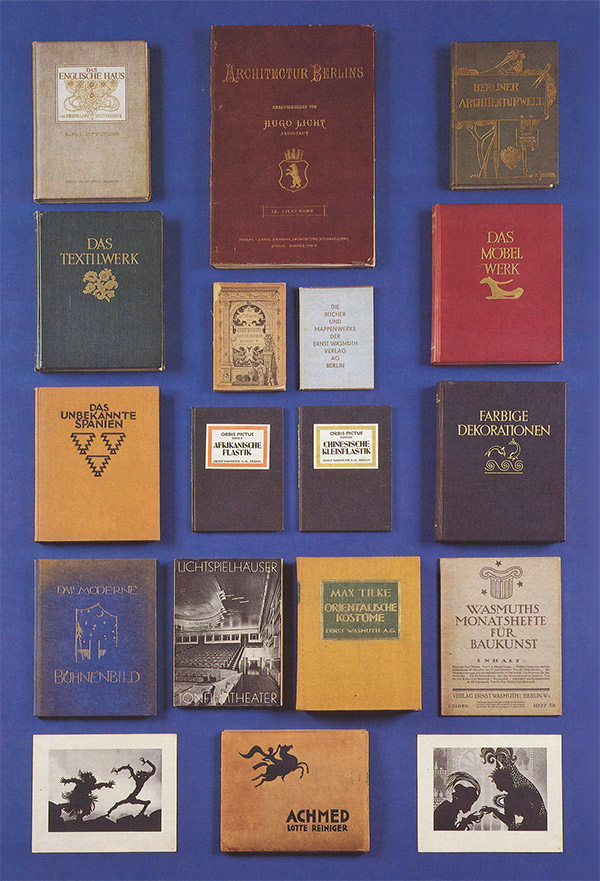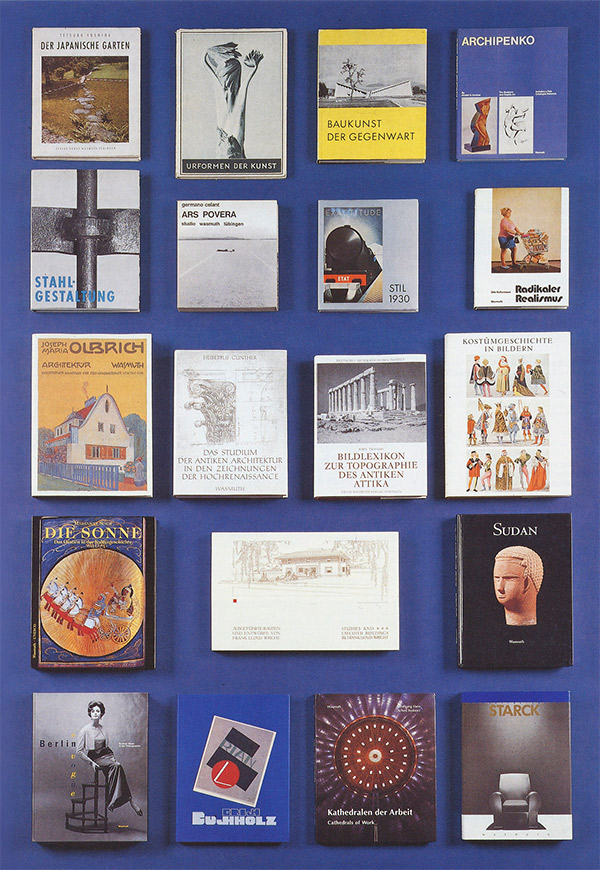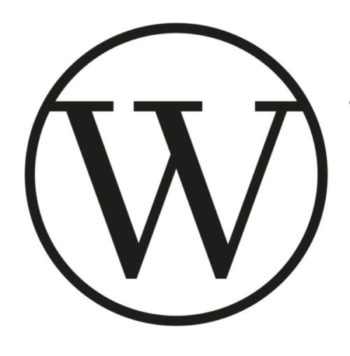The Ernst Wasmuth Verlag is one of the oldest family-run publishers in Germany of books about architecture, archeology, art, and design. Ernst J. Wasmuth has been the director since 1990 in the third generation. The firm was founded in 1872 in Berlin by Ernst Wasmuth and rapidly advanced to become one of the leading architecture and art book publishers in central Europe.
The technologically backward status of 19th century picture reproduction became the focus of the firm, which quickly understood the significance of the rapidly evolving technology of photography for publishing. The publisher sent photographers throughout the country and later outside Germany who came back with a fill of architectural historical prizes that had never been documented. Fundamental works on architectural history like Fritsch, “Denkmäler deutscher Renaissance” (1880), Dohme, “Barock- und Rokoko-Architektur” (1883), Schäfer, “Holzarchitektur” (1880–82), Hartung, “Motive mittelalterlicher Baukunst” (1895–97), Uhde, “Baudenkmäler in Spanien und Portugal” (1888) were published. Many buildings, which had either been demolished or destroyed during the war, have been preserved for posterity in these magnificent volumes. The complete publication of “Palastarchitektur von Oberitalien und Toskana vom XIII.–XVII. Jahrhundert” took 46 years to publish, from 1879 to 1925.

In 1884 Ernst Wasmuth acquired the commercial building at Markgrafenstrasse 35 which brought the publishing business, the department for graphic design, the photographic studio and the retail bookshop under one roof. But the founder was not able to enjoy the fruits of his labors because he died in 1897. The firm was run by his sister-in-law Antonie Wasmuth and her manager, Otto Dorn, until the founder’s nephew, Günther Wasmuth could take over the firm de jure in 1914 and de facto in 1919 after he returned from the First World War.
While famous works like Hermann Muthesius’ “Das englische Haus” (1904) or Frank Lloyd Wright’s “Ausgeführte Bauten und Entwürfe. Studies and Executed Buildings” (1910), but also the magazine “Der Städtebau” (1904), which was conceptualized at that time by Camillo Sitte, as well as “Die Architektur im XX. Jahrhundert. Architecture of the XX. Century” (1911) were published before the break caused by the First World War, in the 1920s and afterwards Günther Wasmuth was able to lend the firm a new luster. The architectural discussion in Germany was marked by “Wasmuths Lexikon der Baukunst” and “Wasmuths Monatshefte für Baukunst” as well as by their influential theoretician and building culture politician, Werner Hegemann (“Das steinerne Berlin”).
From 1921 to 1927 the series “Orbis Pictus – Weltkunstbücherei”, edited by Paul Westheim, and from 1922 to 1929 the famous series “Orbis Terrarum” were published by Wasmuth. In 1924 H. Th. Bossert’s monumental “Ornamentwerk” and in 1926 Karl Blossfeldt’s “Urformen der Kunst” were released. In 1926 Paul Zucker’s “Moderne Theater und Lichtspielhäuser” put a spotlight on Berlin as a hub of film-making. That same year, Lotte Reiniger’s animated silhouette film “Die Abenteuer des Prinzen Ahmed” opened in the Berlin Volksbühne on the Bülowplatz while Wasmuth published the art folder with the same name.
In the series “Werkkunstbücherei” the individual branches of handicrafts were portrayed: Flemming, “Das Textilwerk” (1927), Höver, “Das Eisenwerk” (1927), Degering, “Die Schrift” (1929), Schmitz, “Das Möbelwerk”, to mention just a few.
Günther Wasmuth counted many artists and authors among his friends at this time, including Carl Einstein, Ivan Puni, Hans Poelzig, Lotte Reiniger, Helmut Th. Bossert. The firm was also hit hard by the turbulences of the world-wide economic crisis in 1931, and the publisher lost many important, often Jewish authors and friends as a consequence of the takeover of power by Hitler, until Günther Wasmuth himself was confined in the concentration camp in Sachsenhausen in 1944.

Severely scathed by his years in detention, Günther Wasmuth began with very modest means to steadily rebuild the firm in 1946 in Tübingen. The publishing focal points were still architecture, art, and handicrafts. Archeology was to be strongly represented by collaboration with the German Archeological Institute in the form of many individual publications, like the topographical illustrated encyclopedias of Rome, Athens and Istanbul, as well as archeological series like the “Istanbuler Mitteilungen”, or the “Istanbuler Forschungen”, or the “Zeitschrift für Orient-Archäologie” or the “Archäologischer Anzeiger”.
Ernst J. Wasmuth started directing the firm in 1990. In addition to fundamental works on architectural history, many publications about modern architecture, art, and design have been and continue to be published. In response to changes over time, the publisher has diversified into museum guides, exhibition catalogues, portraits of architects and high quality illustrated volumes on photography and applied art. In collaboration with the German Architecture Museum Frankfurt among other publications the following have appeared: “Schriftenreihe zur Plan- und Modellsammlung des DAM” (beginning in 1996), “Eine Architektur für alle Sinne. Die Arbeiten von Eileen Gray” (1996; edited by Caroline Constant, Wilfried Wang), “Helmut Jacoby. Meister der Architekturzeichnung” (2001; edited by Helge Bofinger, Wolfgang Voigt), “Paul Schmitthenner 1884–1972” (2003; edited by Wolfgang Voigt, Hartmut Frank), “Dominikus Böhm 1880–1955” (2005; edited by Wolfgang Voigt, Ingeborg Flagge), “Paul Bonatz 1877–1956” (2010; edited by Wolfgang Voigt, Roland May), “Interferenzen – Interférences. Architektur Deutschland – Frankreich 1800–2000“ (2013; edited by Jean-Louis Cohen, Hartmut Frank), „Ferdinand Kramer. Die Bauten. The Buildings of Ferdinand Kramer” (2015; edited by Wolfgang Voigt, Philipp Sturm, Peter Körner, Peter Cachola Schmal).
From 1993 to 2013 Wasmuth successfully operated many museum shops belonging to the State Museums in Berlin. The publisher still operates museum shops in the German Technology Museum Berlin and in the Museum of Fine Arts in Leipzig, but Wasmuth’s bookshop and antiquarian bookseller in Berlin shut down the operations as library supplier in 2014.
The Ernst Wasmuth Verlag is not the only publisher, which has been confronted with the challenge posed by the explosive developments in digitalization over the last two decades. In order to meet that challenge the publisher can draw on a stable tradition, which was always interested in new developments, displaying today a readiness to go on the offensive in the face of the innovation ushered in by the age of the internet and social media.
It’s always been a matter of integrating the new while maintaining and continuing the tried and true.
